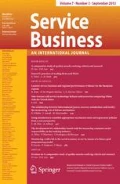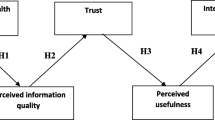Abstract
Delivering rich information is the key success factor for service business websites. Numerous studies have investigated useful guidelines to deliver rich information. The implicit assumption made by these studies is individual homogeneity. This study argues that this is only one side of the story, as individual heterogeneity is also important. Specifically, this study questions relationships between personal dispositional factors and the person’s perception of information richness. Dispositional factors of interest are age and personality. This study adopted information processing theory as its theoretical lens. A review of literature through the lens leads to the development of six hypotheses. The insurance industry provided the context of this study. Data were collected from 110 potential customers of 10 insurance organizations. The Hierarchical Linear Modeling technique was utilized for model building and hypotheses testing. The result revealed that aging individuals often find information as low in richness. Furthermore, those with high consciousness and extraversion generally perceived information as higher in richness. Lastly, the other three dimensions of personality showed no association with information richness.

Similar content being viewed by others
References
Balasubramanian S, Konana P, Menon NM (2003) Customer satisfaction in virtual environments: a study of online investing. Manage Sci 49(7):871–889
Bales PB, Lindenberger U (1997) Emergence of a powerful connection between sensory and cognitive functions across adult life span: a new window to the study of cognitive aging? Psychol Aging 12(1):12–21
Barki H, Hartwick J (2001) Interpersonal conflict and its management in information system development. MIS Q 25(2):195–228
Barnes SJ, Vidgen R (2003) Measuring web site quality improvements. Ind Manag Data Syst 103(5):297–309
Barrick MR, Mount MK (1991) The big five personality dimensions and job performance: a meta-analysis. Pers Psychol 44:1–26
Beaubien JM, Hamman WR, Holt RW, Boehm-Davis DA (2001) The application of hierarchical linear modeling (HLM) techniques in commercial aviation research. In: The 11th annual symposium on aviation psychology. The Ohio State University Press, Columbus
Branje SJT, Van Lieshout CFM, Van Aken MAG (2004) Relations between Big Five personality characteristics and perceived support in adolescents’ families. J Pers Soc Psychol 86(4):615–628
Butler T, Murphy C (2007) Understanding the design of information technologies for knowledge management in organizations: a pragmatic perspective. Inf Syst J 17(2):143–163
Chen K, Yen DC, Huang AH (2004) Media selection to meet communication contexts: comparing e-mail and instant messaging in an undergraduate population. Commun Assoc Inf Syst 14:387–405
Chung J, Tan FB (2004) Antecedents of perceived playfulness: an exploratory study on user acceptance of general information-searching websites. Inf Manag 41(9):869–881
Daft RL, Langel RH (1986) Organizational information requirements, media richness, and structural design. Manage Sci 32(5):554–571
Daft RL, Weick KE (1984) Toward a model of organizations as interpretation systems. Acad Manag Rev 9(2):284–295
DeLone WH, McLean ER (2004) Measuring e-Commerce success: applying the DeLone & McLean information systems success model. Int J Electron Commer 9(1):31–47
Dennis R, Hilmer KM (1997) Information exchange and use in GSS and verbal group decision making: effects of minority influence. J Manag Inf Syst 14(3):61–88
Dickson GW, DeSanctis G, McBride DJ (1986) Understanding the effectiveness of computer graphics for decision support: a cumulative experimental approach. Commun ACM 29(1):40–47
Digman JM (1997) Higher-order factors of the big five. J Pers Soc Psychol 73(6):1246–1256
Elsbach KD, Kramer RM (2003) Assessing creativity in Hollywood pitch meetings: evidence for a dual-process model of creativity judgements. Acad Manag J 46(3):283–301
Feldman DC, Ng TWH (2007) Careers: mobility, embeddedness, and success. J Manag 33(3):350–377
Fischer P, Greitemeyer T, Frey D (2008) Self-regulation and selective exposure: the impact of depleted self-regulation resources on confirmatory information processing. J Pers Soc Psychol 94(3):382–395
Geletkanycz MA, Black SS (2001) Bound by the past? Experience-based effects on commitment to the strategic status quo. J Manag 27(1):3–21
Goldberg LR (1990) An alternative “Description of Personality”: the big-five factor structure. J Pers Soc Psychol 59(6):1216–1229
Hau LN, Thuy PN (2012) Impact of service personal values on service value and customer loyalty: a cross-service industry study. Serv Bus 6(2):137–155
Hess TJ, Fuller MA, Mathew J (2006) Involvement and decision-making performance with a decision aid: the influence of social multimedia. J Manag Inf Syst 22(3):15–54
Hoyle RH (2006) Personality and self-regulation: trait and information processing perspective. J Pers 74(6):1507–1526
Ilies R, Scott BA, Judge TA (2006) The interactive effects of personal traits and experienced states on intraindividual patterns of citizenship behavior. Acad Manag J 49(3):561–575
John OP, Srivastava S (1999) The Big Five trait taxonomy: history, measurement, and theoretical perspectives. Handbook of personality: theory and research. Guilford Press, New York
Kang I, Cheon D, Shin MM (2011) Advertising strategy for outbound travel services. Serv Bus 5(4):361–380
Kenny A, Mannetti L, Pierro A, Livi S, Kashy DA (2002) The statistical analysis of data from small groups. J Pers Soc Psychol 83(1):126–137
Klein KJ, Lim BS, Jessica L, Mayer DM (2004) How do they get there? An examination of the antecedents of centrality in team networks. Acad Manag J 47:952–963
Kline RB (1998) Principles and practice of structural equation modeling. Guilford, New York
Kumar N, Stern LW, Anderson JC (1993) Conducting interorganizational research using key informants. Acad Manag J 36(6):1633–1651
Lim KH, Benbasat I (2000) The effect of multimedia on perceived equivocality and perceived usefulness of information systems. MIS Q 24(3):449–471
MacInnis J, Jaworski BJ (1989) Information processing from advertisements: toward an integrative framework. J Mark 53(4):1–23
Mata R, Schooler LJ, Rieskamp J (2007) The aging decision maker: cognitive aging and the adaptive selection of decision strategies. Psychol Aging 22(4):796–810
McElroy JC, Hendrickson AR, Townsend AM, DeMarie SM (2007) Dispositional factors in Internet use: personality versus cognitive style. MIS Q 31(4):809–820
Miller G (1956) The magical number seven, plus or minus two: some limits on our capacity for processing information. Psychol Rev 63(2):81–97
Molla A, Heeks R (2009) Exploring E-commerce benefits for businesses in a developing country. Inf Soc 23(2):95–108
Morrison EW (2002) Newcomers’ relationships: the role of social network ties during socialization. Acad Manag J 45(6):1149–1160
Mount MK, Barrick MR (1998) Five reasons why the “Big Five” article has been frequently cited. Pers Psychol 51(4):849–857
Otondo RF, van Scotter JR, Allen DG, Palvia P (2008) The complexity of richness: media, message, and communication outcomes. Inf Manag 21(1):21–30
Park D (2000) The basic mechanisms accounting for age-related decline in cognitive function. Cognitive aging: a primer. Psychology Press, Philadelphia
Pitts MG, Browne GJ (2004) Stopping behavior of systems analysts during information requirements elicitation. J Manag Inf Syst 21(1):203–226
Raja U, Johns G, Ntalianis F (2004) The impact of personality on psychological contracts. Acad Manag J 47(3):350–367
Raudenbush SW, Bryk AS (2002) Hierarchical linear models: applications and data analysis methods. Sage Publications, London
Richter T, Schroeder S, Wohrmann B (2009) Your don’t have to believe everything you read: background knowledge permits fast and efficient validation of information. J Pers Soc Psychol 96(3):538–558
Robertson T, Clarke S (2005) A meta-analytic review of the Big Five personality factors and accident involvement in occupational and non-occupational settings. J Occup Organ Psychol 78(3):355–376
Salancik R, Pfeffer J (1978) A social information processing approach to job attitudes and task design. Adm Sci Q 23(2):224–253
Schaffer BS, Riordan CM (2003) A review of cross-cultural methodologies for organizational research: a best-practices approach. Organ Res Methods 6(2):169–215
Schneider B, Ehrhart MG, Mayer DM, Saltz JL, Niles-jolly K (2005) Understanding organization-customer links in service settings. Acad Manag J 48(6):1017–1032
Shalley CE, Zhou J, Oldham GR (2004) The effects of personal and contextual characteristics on creativity: when should we go from here? J Manag 30(6):933–958
Shneiderman B (2007) Creativity support tools accelerating discovery and innovation. Commun ACM 50(12):19–32
Taggar S (2002) Individual creativity and group ability to utilize individual creative resources: a multilevel model. Acad Manag J 45(2):315–330
Tam KY, Ho SY (2005) Web personalization as a persuasion strategy: an elaboration likelihood model perspective. Inf Syst Res 16(3):271–291
Tung LL, Xu Y, Tan FB (2009) Attributes of web site usability: a study of web users with the repertory grid technique. Int J Electron Commer 13(4):97–126
Turetken O, Schuff D (2007) The impact of context-aware fisheye models on understanding business processes: an empirical study of data flow diagrams. Inf Manag 44(1):40–52
Van den Bos K (2003) On the subjective quality of social justice: the role of affect as information in the psychology of justice judgments. J Pers Soc Psychol 85(3):482–498
Vazire S, Gosling SD (2004) E-Perceptions: personality impressions based on personal websites. J Pers Soc Psychol 87(1):123–132
Verhaeghen P, Salthouse TA (1997) Meta-analyses of age-cognition relations in adulthood: estimates of linear and nonlinear age effects and structural models. Psychol Bull 112(3):231–249
Yellen RE, Winniford MA, Sanford CC (1995) Extraversion and introversion in electronically-supported meetings. Inf Manag 28(1):63–74
Author information
Authors and Affiliations
Corresponding author
Appendix
Appendix
1.1 Measurement items and reliability
Information Richness Item (α = 0.87)
I find the organization’s website
-
1.
Provides accurate information
-
2.
Provides timely information
-
3.
Provides easy to understand information
-
4.
Provides information at the right level of detail
Extraversion Item (α = 0.71)
I see myself as someone who…
-
1.
Is talkative
-
2.
Is full of energy
-
3.
Generates a lot of enthusiasm
-
4.
Tends to be quiet (reverse coding)
-
5.
Is sometimes shy, inhibited (reverse coding)
-
6.
Is outgoing, sociable
Agreeableness (α = 0.71)
I see myself as someone who…
-
1.
Is helpful and unselfish with others
-
2.
Has forgiving nature
-
3.
Is generally trusting
-
4.
Is considerate and kind to almost everyone
-
5.
Likes to cooperate with others
Conscientiousness (α = 0.77)
I see myself as someone who…
-
1.
Does a thorough job
-
2.
Can be somewhat careless (reverse coding)
-
3.
Tends to be disorganized (reverse coding)
-
4.
Does things efficiently
-
5.
Makes plans and follows through with them
-
6.
Is easily distracted (reverse coding)
Neuroticism (α = 0.70)
I see myself as someone who…
-
1.
Is relaxed, handles stress well (reverse coding)
-
2.
Worries a lot
-
3.
Can be moody
-
4.
Gets nervous easily
Openness (α = 0.78)
I see myself as someone who…
-
1.
Is original, comes up with new ideas
-
2.
Is curious about many different things
-
3.
Has an active imagination
-
4.
Is inventive
-
5.
Values artistic, aesthetic experiences
-
6.
Is sophisticated in art, music, or literature
Rights and permissions
About this article
Cite this article
Patrakosol, B., Lee, S.M. Information richness on service business websites. Serv Bus 7, 329–346 (2013). https://doi.org/10.1007/s11628-012-0162-x
Received:
Accepted:
Published:
Issue Date:
DOI: https://doi.org/10.1007/s11628-012-0162-x




